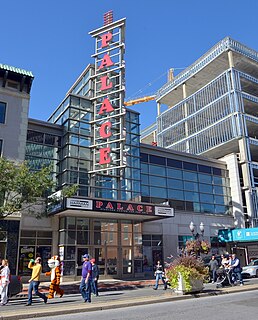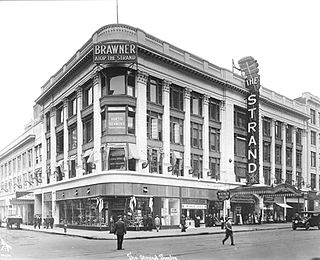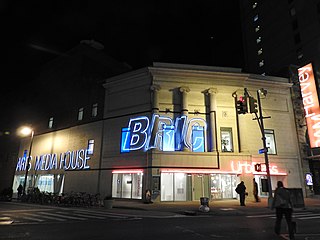Strand Theatre or Strand Theater may refer to:

Thomas White Lamb (1871–1942) was a Scottish-born, American architect. He was one of the foremost designers of theaters and cinemas in the 20th century.

The Kings Theatre, formerly Loew's Kings Theatre, is a live performance venue in the Flatbush neighborhood of Brooklyn, New York City. Opened by Loew's Theatres as a movie palace in 1929 and closed in 1977, the theater sat empty for decades until a complete renovation was initiated in 2010. The theater reopened to the public on January 23, 2015 as a performing arts venue. It was listed on the National Register of Historic Places on August 22, 2012.
The Cultural District is a fourteen-square block area in Downtown Pittsburgh, USA bordered by the Allegheny River on the north, Tenth Street on the east, Stanwix Street on the west, and Liberty Avenue on the south.

The Palace Theatre in downtown Stamford, Connecticut, United States, comprises two facilities on Atlantic Street: the restored Palace Theatre, and the Rich Forum, both within four blocks of each other:

The Olympia Theater is a theater located in Miami, Florida. Designed by John Eberson in his famed atmospheric style, the theater opened in 1926. Throughout its history, the venue has served as a movie theater, concert venue and performing arts center. In 1984, it received historical designation by the NRHP. The Olympia Theater and its sister venue, the Tampa Theatre are the only remaining atmospheric theatres in Florida.

The Cabot Performing Arts Center is located at 286 Cabot Street in Beverly, Massachusetts.

The Brooklyn Paramount Theater is a former movie palace at 1 University Plaza at the intersection of Flatbush and DeKalb Avenues in downtown Brooklyn, New York. Opened in 1928, the building has been owned by Long Island University (LIU) since 1954. Converted for use by LIU as classroom space and a gymnasium, the building retains much of the theater's original decorative detail. Until recently the venue operated as a 1200-seat multi-purpose arena, formerly home to the Brooklyn Kings basketball team. It is now in the planning stages of a renovation to reopen the theater as a performing arts venue in 2019.

The Strand Theatre was an early movie palace located at 1579 Broadway, at the northwest corner of 47th Street and Broadway in Times Square, New York City. Opened in 1914, the theater was later known as the Mark Strand Theatre, the Warner Theatre, and the Cinerama Theatre. It closed as the RKO Warner Twin Theatre, and was demolished in 1987.

The Colonial Theater is a historic theater in Idaho Falls, Idaho, founded in 1919 as a venue for live performances. From 1929 until 1990, it operated as a movie theater under the name The Paramount Theater. In the 1990s, the theater was renovated, and its original name was restored. It is currently part of the Willard Arts Center arts complex, owned and operated by the Idaho Falls Art Council.

The Broadway Theater District in the Historic Core of Downtown Los Angeles is the first and largest historic theater district listed on the National Register of Historic Places (NRHP). With twelve movie palaces located along a six-block stretch of Broadway, it is the only large concentration of movie palaces left in the United States. The same six-block stretch of Broadway, and an adjacent section of Seventh Street, was also the city's retail hub for the first half of the twentieth century, lined with large and small department stores and specialty stores.

Pike's Opera House, later renamed the Grand Opera House, was a theater in New York City on the northwest corner of 8th Avenue and 23rd Street, in the Chelsea neighborhood of Manhattan. It was constructed in 1868, at a cost of a million dollars, for distiller and entrepreneur Samuel N. Pike (1822–1872) of Cincinnati. The building survived in altered form until 1960 as an RKO movie theater, after which it was replaced by part of Penn South, an urban renewal housing development.

Strand Theatre is a restored vaudeville house located in Uphams Corner in Dorchester, Boston, Massachusetts. It is owned by the City of Boston and managed by the Mayor's Office of Arts and Culture.

The Capitol Theatre is a historic theatre located in the village of Port Chester, Westchester County, New York. It was designed by noted theater architect Thomas W. Lamb (1871–1942) and built in 1926. The 1,800-seat facility operates as a concert venue, hosting musicians and occasionally comedians, as owned and operated by NYC-based concert promoter Peter Shapiro. The Capitol Theatre has had a long history, with tenures as a movie theater and catering hall, in addition to hosting concerts.
The Beacon Theatre was an American Art Deco performing arts theater located in Beacon, New York, in the Hudson Valley, on Main Street in the city's downtown section, across from Fishkill Creek. The theater was run by 4th Wall Productions, which has been producing live theater in the Hudson Valley since 1994, from 2010 until they sold the building in 2015. The main stage was gutted and converted into residential units, with the second floor converted into a smaller performance space.

BRIC, formerly known as BRIC Arts Media or Brooklyn Information & Culture, is a non-profit arts organization based in Brooklyn, New York founded in 1979 as the "Fund for the Borough of Brooklyn". A presenter of free cultural programming in Brooklyn, it incubates and showcases work by artists and media-makers with programs reaching hundreds of thousands of people each year.
UrbanGlass, located on Fulton Street in the historic 1918 Strand Theatre in the Downtown Brooklyn Cultural District is the United States' first and largest artist glass studio and the New York metropolitan area's leading glass-blowing facility.

Loew's State Theatre was a movie theater at 1540 Broadway on Times Square in New York City. Designed by Thomas Lamb in the Adam style, it opened on August 29, 1921, as part of a 16-story office building for the Loew's Theatres company, with a seating capacity of 3,200 and featuring both vaudeville and films. It was the first theater on Broadway to cost $1 million. It was initially managed by Joseph Vogel, who later became president of Loew's Inc. and then MGM.
The Colonial Theatre in New York City was at Broadway and 62nd Street in what was then the San Juan Hill neighborhood on the Upper West Side, Manhattan. Originally named the Colonial Music Hall, it was opened in 1905 by Frederic Thompson and Elmer "Skip" Dundy. Designed by George Keister, the theater had a seating capacity of 1,293.

Nitehawk Cinema is a dine-in independent movie theater in Brooklyn, New York City. It operates two locations, in the neighborhoods of Williamsburg and Park Slope. The theater, which offers a menu of food and drinks that can be ordered and consumed while patrons view films, was the first liquor licensed movie theater in the state of New York, and the first movie theater in New York City to offer table service.















